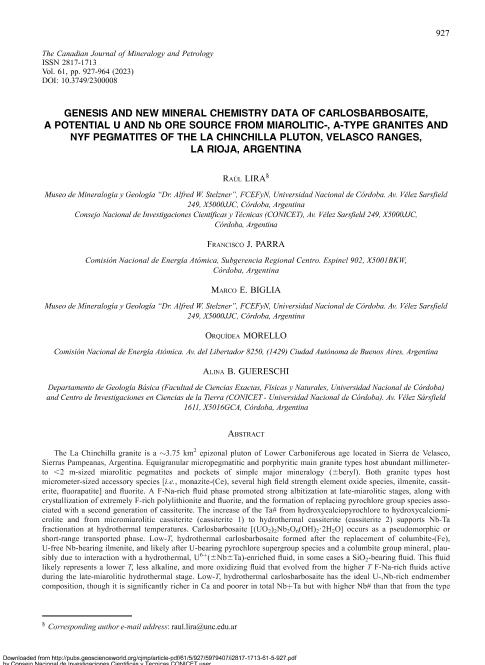Artículo
Genesis and new mineral chemistry data of carlosbarbosaite, a potential U and Nb ore source from miarolitic-, A-type granites and NYF pegmatites of the La Chinchilla pluton, Velasco ranges, La Rioja, Argentina
Fecha de publicación:
09/2023
Editorial:
Mineralogical Association of Canada
Revista:
The Canadian Journal of Mineralogy and Petrology
ISSN:
2817-1713
Idioma:
Inglés
Tipo de recurso:
Artículo publicado
Clasificación temática:
Resumen
The La Chinchilla granite is a ~3.75 km2 epizonal pluton of Lower Carboniferous age located in Sierra de Velasco, Sierras Pampeanas, Argentina. Equigranular micropegmatitic and porphyritic main granite types host abundant millimeter-, to < 2 m-sized miarolitic pegmatites and pockets of simple major mineralogy (± beryl). Both granite types host micrometer sized accessory species [i.e., monazite-(Ce), several high field strength element oxide species, ilmenite, cassiterite, fluorapatite] and fluorite. A F-Na rich fluid phase promoted strong albitization at late miarolitic stages, along with crystallization of extremely F-rich polylithionite and fluorite, and the formation of replacing pyrochlore group species associated with a second generation of cassiterite. The increase of the Ta# from hydroxycalciopyrochlore to hydroxycalciomicrolite and from micromiarolitic cassiterite (cassiterite 1) to hydrothermal cassiterite (cassiterite 2), supports Nb-Ta fractionation at hydrothermal temperatures. Carlosbarbosaite [(UO2)2Nb2O6(OH)2•2H2O] occurs as a pseudomorphic or as a short-range transported phase. Indigenous carlosbarbosaite formed after columbite-(Fe), U-free Nb-bearing ilmenite and likely after U-bearing pyrochlore supergroup species and a columbite group mineral, plausibly due to interaction with a hydrothermal-, U6+(±Nb±Ta)-enriched fluid, in some cases a SiO2-bearing fluid. This fluid likely represents a lower temperature, less alkaline and more oxidizing fluid that evolved from the higher temperature F-Na-rich fluids active during the late-miarolitic hydrothermal stage. Indigenous carlosbarbosaite has the ideal U-, Nb-rich endmember composition, though is significantly richer in Ca and poorer in total Nb+Ta but with higher Nb# than the one from the type locality. Supergene fluids deposited the transported type which attained economic concentrations in a fault zone where restricted-, likely alkaline oxidizing-conditions could have favored Nb mobility.
Archivos asociados
Licencia
Identificadores
Colecciones
Articulos(CICTERRA)
Articulos de CENTRO DE INVEST.EN CS.DE LA TIERRA
Articulos de CENTRO DE INVEST.EN CS.DE LA TIERRA
Citación
Lira, Raul; Parra, Francisco; Biglia, Marco Esteban; Morello, Orquídea; Guereschi, Alina Beatriz; Genesis and new mineral chemistry data of carlosbarbosaite, a potential U and Nb ore source from miarolitic-, A-type granites and NYF pegmatites of the La Chinchilla pluton, Velasco ranges, La Rioja, Argentina; Mineralogical Association of Canada; The Canadian Journal of Mineralogy and Petrology; 61; 5; 9-2023; 927-964
Compartir
Altmétricas




